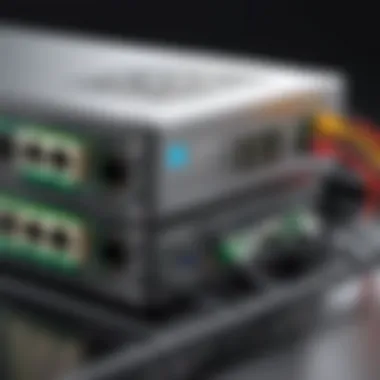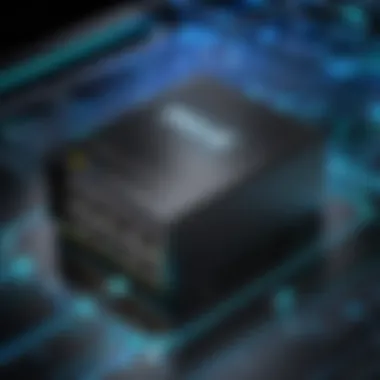Exploring the Impact and Uses of PoE Switches


Intro
Power over Ethernet (PoE) switches have become essential components in modern networking. Their ability to deliver both data and electrical power through a single cable streamlines the setup of various network devices. In this article, we will explore the functionalities of PoE switches and their applications. Understanding these elements is crucial for both technology professionals and enthusiasts.
PoE technology simplifies network design by reducing the complexity of traditional wiring. This method is prevalent in devices like IP cameras, VoIP phones, and wireless access points, where it enhances installation efficiency and reduces cabling costs. Furthermore, the integration of power and data transmission has significant implications for various sectors, from corporate environments to smart homes. In this context, grasping the underlying concepts of PoE and its practical applications will enhance understanding and facilitate informed decisions regarding network infrastructure.
Foreword to PoE Switches
Power over Ethernet (PoE) switches play a vital role in modern networking by providing dual functionalities of data and power transmission over a single cable. This innovative approach simplifies infrastructure setups, reduces wiring clutter, and enhances overall efficiency. As the demand for reliable network connections grows, understanding the functionality and capabilities of PoE switches becomes essential for IT professionals and organizations alike.
Definition of PoE
Power over Ethernet enables the delivery of electrical power, along with data, using standard Ethernet cables. The standard types of cables used include Cat5e, Cat6, and Cat6a, which support both data and power flow. This technology allows devices, like IP cameras and wireless access points, to receive power without needing separate power sources. The seamless combination of power and networking is what makes PoE so appealing in today’s tech landscape.
Historical Background
PoE technology has evolved significantly since its inception. The first formal standard, IEEE 802.3af, emerged in 2003, allowing for a maximum power output of 15.4 watts per port. The subsequent standard, IEEE 802.3at, introduced in 2009, increased that capacity to 30 watts. The latest standard, IEEE 802.3bt, further enhances capabilities by allowing up to 60 or even 100 watts per port, accommodating more power-hungry devices. This evolution demonstrates not only an increased dependency on IP-based devices but also a push towards more efficient networking solutions.
Understanding the background of PoE technology highlights how networking standards adapt to changing demands, making the technology relevant and essential for current and future networking needs.
"PoE technology is not just a convenience; it's a solution that tackles modern connectivity challenges."
This foundational knowledge about PoE switches is critical for those involved in network design, deployment, or management. As the integration of various devices continues, recognizing the capabilities and applications of PoE switches becomes more important.
The Mechanics of Power Over Ethernet
Understanding the mechanics of Power over Ethernet (PoE) is crucial for comprehending its role in modern networks. This technical insight illuminates how PoE enables simultaneous power and data transmission using standard Ethernet cables. The synergy created by this integration simplifies installations and enhances the capabilities of various network devices. With PoE, one cable replaces multiple individual connectors, reducing clutter and potential points of failure.
How PoE Works
PoE operates by sending electrical power along with data through twisted pair cables in a network. Standard Ethernet cables, such as Cat 5e or Cat 6, can transmit power up to a distance of 100 meters. At one end, a PoE switch or injector introduces power into the Ethernet cable. At the other end, a PoE-enabled device receives both power and data. This process relies on specific power negotiation protocols that ensure safe and efficient power delivery.
Types of PoE Standards
Different standards of PoE each serve specific needs and offer various power output capacities, making it essential to understand their characteristics. They include:
IEEE 802.3af
The IEEE 802.3af standard provides up to 15.4 watts of power per port. This makes it suitable for devices with lower power requirements, such as basic VoIP phones. Its main attraction lies in its wide compatibility and relatively simple implementation. This standard is popular because it meets the power needs of many conventional network devices without requiring extensive infrastructure changes.
Key characteristics include:
- Max power delivery of 15.4 watts
- Can support devices such as IP cameras and basic wireless access points
However, it may not suffice for high-powered devices needing more energy.
IEEE 802.3at
IEEE 802.3at, also known as PoE+, offers enhanced power delivery at a maximum of 30 watts per port. This standard caters to devices with moderate power requirements, such as PTZ (pan-tilt-zoom) cameras and more advanced wireless access points. With its ability to handle higher power loads, it's a preferred choice for most medium-scale deployments.
Key features include:
- Max power capacity of 30 watts
- Supports a broader range of devices compared to IEEE 802.3af
The downside is potential compatibility issues with older equipment that cannot handle the increased power.
IEEE 802.3bt


IEEE 802.3bt represents the latest development in PoE technology, allowing power delivery up to 60 watts for Type 3 and up to 100 watts for Type 4 devices per port. This flexibility allows it to power energy-intensive devices, including multiple cameras, advanced PoE lights, and even some PC systems. It signifies a leap forward in capability, making it highly valuable in environments needing high power.
Unique aspects include:
- Max power delivery of 60 to 100 watts
- Designed for high-demand use cases, such as smart buildings that integrate various IoT devices
The main challenge is that existing devices may require updates to fully reap the benefits of this standard.
PoE technology streamlines the operational workflow by powering network devices with fewer cables, enhancing efficiency in device management.
Understanding these standards provides essential insights into selecting the right PoE technology for specific applications, ensuring optimal performance and efficiency in network designs.
Applications of PoE Switches
The applications of Power over Ethernet (PoE) switches are vast and varied, illustrating their significance in modern networking environments. PoE switches enable the delivery of both power and data through a single Ethernet cable, simplifying cabling requirements and reducing installation time. Their ability to power multiple devices adds flexibility to network design while minimizing additional infrastructure costs. Given the growing dependency on networked devices, understanding the practical applications of PoE switches is essential for any organization looking to innovate and modernize its networking strategies.
Network Devices Powered by PoE
IP Cameras
IP cameras benefit significantly from PoE technology. By using PoE, these cameras eliminate the need for separate power sources, which can often complicate installations, especially in hard-to-reach areas. The key characteristic of IP cameras is their ability to provide real-time video feeds over the internet. This capability is not only beneficial for surveillance purposes but also aids in remote monitoring in various settings.
One unique feature of IP cameras is their compatibility with network video recorders (NVRs). This results in streamlined data management, enabling easy access to recorded footage. However, a downside can include reliance on network performance; if the network experiences issues, video quality may suffer, potentially hampering security monitoring.
VoIP Phones
VoIP (Voice over Internet Protocol) phones are another notable application of PoE switches. These devices use the same Ethernet connections that handle data traffic. Their primary advantage is the seamless integration of voice communication into the existing data network. VoIP phones enhance communication efficiency in organizations by offering features like call forwarding, voicemail, and conference calling.
They are particularly advantageous in environments where traditional phone systems can be cost-prohibitive. A potential disadvantage, though, is the dependency on network power; a power outage can impact both data and voice services unless backed up by alternative power solutions.
Wireless Access Points
Wireless access points (WAPs) also benefit from PoE technology. These devices extend the coverage of wireless networks and are crucial in providing connectivity in both open and discrete environments. The key feature of WAPs is that they can be placed in optimal locations without needing nearby power outlets, allowing greater flexibility in network layout.
By using PoE to power WAPs, organizations can deploy them in high-density areas, ensuring coverage and performance remain consistent. However, one limitation may be that if many devices are powered through a single switch, it can lead to power management issues, potentially affecting the performance of connected devices.
Use Cases in Various Environments
Corporate Offices
In corporate offices, PoE switches streamline network design by providing power to devices across large spaces without the complications of managing multiple cables. A distinctive feature of corporate environments is the diversity of devices used, from surveillance cameras to telephony systems. PoE’s versatility allows these companies to equip their offices with modern technology that enhances productivity while lowering installation costs.
However, one consideration is the power budget of the switches, as multiple devices might tap into the same power source. This requires careful assessment to ensure that the total wattage does not exceed the switch’s capacity.
Educational Institutions
Educational institutions utilize PoE switches to create smart classrooms equipped with interactive displays and internet-enabled devices. The primary benefit here is simplifying setup and operation—fewer cables mean a more straightforward installation and maintenance process. Furthermore, PoE allows for the deployment of various devices that enhance learning experiences, such as projectors and cameras.
One unique aspect of this environment is the need for robust security systems. PoE technology enables easy integration of security cameras into the school's network, ensuring safety without sacrificing performance. On the downside, the initial cost of implementing PoE infrastructure can be a consideration for budget-strapped institutions.
Smart Buildings
Smart buildings leverage PoE switches for efficient energy management and enhanced connectivity. A key characteristic of these environments is the integration of smart sensors and devices that regulate heating, lighting, and security systems. PoE allows these devices to function effectively without requiring extensive electrical work.
A unique feature of smart buildings is their ability to use data analytics to optimize operations, which can lead to significant savings over time. However, the complexity of integrating various systems can create challenges in ensuring compatibility and performance across devices. Organizations must navigate these challenges carefully to maximize the benefits of their PoE-enabled solutions.
PoE technology supports a wide range of network devices, enhancing installation flexibility and operational efficiency.
Benefits of Using PoE Switches


Power over Ethernet (PoE) switches have rapidly gained attention due to their ability to merge power delivery with data transmission. The benefits of PoE switches are manifold, extending well beyond mere convenience. This section will dissect the crucial advantages, emphasizing how they transform networking environments while addressing practical considerations in deployment.
Simplified Cabling Infrastructure
One of the immediate advantages of deploying PoE switches is the simplified cabling infrastructure. Traditionally, networks required separate cabling for power and data. This not only increased the complexity of installations but also resulted in higher costs and potential signal interference.
With PoE, a single Ethernet cable can transmit both data and power. This streamlining means fewer cables to manage, reducing clutter and making maintenance simpler. Furthermore, installation becomes far less labor-intensive. As a result, organizations can save time and cost on initial setups and future upgrades, making PoE a more attractive choice for those looking to modernize their infrastructure.
Cost Efficiency
In addition to reduced cabling, cost efficiency is another key benefit of PoE switches. The integration of power delivery into the same cable can lead to significant savings over time. This financial efficiency arises from a few areas:
- Reduced Installation Costs: Less cabling and fewer electrical outlets mean lower overall labor costs during installation.
- Lower Infrastructure Requirements: Organizations can forgo the need for specialized electrical wiring or additional circuits, leading to reduced investment in physical infrastructure.
- Energy Management: Many PoE switches come with energy-efficient features, enabling better monitoring and management of energy usage. This can translate into lower energy bills in the long run.
Organizations can also benefit from the flexibility of scaling their networks without high initial costs, making PoE a pragmatic choice for future expansions.
Improved Flexibility and Scalability
The capabilities of PoE switches significantly enhance both flexibility and scalability in networking environments. These advantages are pivotal for businesses and institutions aiming to adapt rapidly to changing demands.
- Modular Expansion: Organizations can easily add new devices such as IP cameras, VoIP phones, or wireless access points without significant overhauls to the infrastructure. This modular approach allows for quick adaptations in response to evolving technology needs.
- Location Agnosticism: Since devices do not need to be near power sources, they can be installed in optimal locations for performance rather than wiring convenience. This feature is especially beneficial in areas where electrical outlets may be limited or inconvenient.
- Remote Management: Many modern PoE switches allow for remote management, making it easy to monitor and control devices across various locations. This capability is beneficial for IT teams managing distributed networks, improving response times and operational efficiency.
"PoE technology empowers organizations with enhanced operational flexibility and efficient energy use, present in both small businesses and larger enterprises."
Choosing the Right PoE Switch
Choosing the right Power over Ethernet switch is crucial for any networking setup that aims to balance efficiency with functionality. The selection process typically hinges on several elements that cater to the specific needs of the network. Factors such as power budget, port count, and whether the switch is managed or unmanaged play vital roles in ensuring that a network functions optimally and caters to its demands. Understanding these parameters helps in making informed decisions that align both with current requirements and future scalability.
Factors to Consider
Power Budget
When it comes to Power over Ethernet, the power budget refers to the total amount of power the switch can deliver across all its ports. This aspect is particularly important because it determines the number and type of devices that can be powered simultaneously. Typically, switches have a specified wattage that guides users in planning device connectivity.
A key characteristic of the power budget is its capacity to handle devices with varying power needs, such as IP cameras or wireless access points. Choosing a switch with a higher power budget can be beneficial, as it allows for the inclusion of devices that might require more power during peak times.
However, one unique feature of the power budget is the necessity to account for power loss due to cable length and quality. While higher wattage might seem advantageous, it’s crucial to ensure this power is effectively transmitted to devices, which could become a disadvantage if the cables are not up to standards. Therefore, balancing power needs and budgeting is essential for a successful deployment.
Port Count
Port count offers another significant variable when choosing a PoE switch. It indicates the number of devices that the switch can support concurrently. A larger port count can be highly beneficial for growing networks, as it provides the flexibility to connect multiple devices without requiring additional hardware.
One important aspect of port count is that it directly correlates with footprint and cost. Higher port counts often lead to larger physical sizes and more substantial upfront investment. This could be a drawback for smaller installations, which may not need as many ports and could overspend on their network setup. An ideal approach is to evaluate current needs while predicting future expansions to select a switch with an appropriate number of ports.
Managed vs Unmanaged
The distinction between managed and unmanaged PoE switches plays a pivotal role in network control and monitoring. Managed switches offer advanced features such as traffic control, VLAN configuration, and network monitoring capabilities. This is beneficial for professionals looking to maintain optimized and secure connections throughout their networks.
In contrast, unmanaged switches are typically plug-and-play devices with no configuration options, which simplifies deployment for less complex setups. However, they lack the flexibility and control provided by managed switches.
One unique feature to consider is scalability; managed switches often allow for future adjustments and modulations based on changing network demands, making them a preferred choice for dynamic environments. Despite their initial higher cost, the long-term advantages, including better performance management and enhanced security protocols, often justify the investment.
Compatibility with Existing Hardware
Compatibility with existing hardware is another critical aspect to evaluate when selecting a PoE switch. This consideration ensures that new equipment integrates smoothly within an established framework without causing disruptions. Devices should ideally complement current networking gear to facilitate seamless communication and data exchange.
Additionally, the selection of PoE switches should involve ensuring that the power output conforms with existing devices' requirements. For example, mismatches in power delivery can result in performance issues or even damage to components.
One common challenge may arise if older hardware lacks PoE capability; in such cases, specialized solutions or adapters may be necessary. Thus, as one explores new acquisitions, paying close attention to compatibility will ensure not only optimal functioning but also cost effectiveness in the long run.


The selection of the right PoE switch is paramount for establishing a reliable and efficient network that scales with the organization's needs.
Current Trends in PoE Technology
Power over Ethernet (PoE) technology is rapidly evolving. Keeping up with current trends is crucial for professionals and organizations. This understanding helps in adopting the latest solutions, maximizing efficiency, and addressing challenges effectively.
Advancements in PoE Standards
Recent advancements in PoE standards have resulted in increased power delivery capabilities. The transition from IEEE 802.3af and IEEE 802.3at to IEEE 802.3bt significantly enhances support for devices demanding higher power.
- Higher Power Output: The IEEE 802.3bt standard supports a power output of up to 60 watts per port, which is essential for modern devices such as high-performance access points and advanced surveillance systems.
- Improved Efficiency: The latest standards have a focus on energy efficiency, allowing for minimal power loss during transmission. This efficiency is increasingly important as data centers seek to reduce their energy footprint.
Organizations adopting these advancements benefit from greater flexibility in their network configurations, enabling them to integrate a wider variety of devices without the need for separate power sources.
Integration with IoT Devices
The integration of PoE technology with Internet of Things (IoT) devices presents a significant trend. As IoT devices proliferate, the demand for efficient power and data delivery solutions grows.
- Seamless Connectivity: PoE simplifies the network connectivity for IoT devices. Devices such as smart cameras, sensors, and automation systems can connect easily with a single cable.
- Scalability: As businesses expand their IoT implementations, PoE allows for easy scalability of networks. Adding new devices does not require extensive rewiring or new power outlets, minimizing downtime and costs.
In summary, the trends in PoE technology reflect a broader shift towards increased power and integration capabilities. Staying updated on these advancements is essential for IT professionals and businesses alike, ensuring they utilize the best available technology for their networking needs.
Keep an eye on evolving PoE standards as they will dictate future capabilities of network infrastructure.
For more information on PoE technology, you can visit Wikipedia or Britannica.
Challenges and Limitations of PoE Switches
Understanding the limitations of Power over Ethernet (PoE) switches is crucial for optimizing network performance and making informed decisions. As organizations increasingly adopt PoE technology for its efficiencies, awareness of its constraints helps to mitigate potential issues. This section discusses two primary challenges: distance limitations and power constraints.
Distance Limitations
PoE technology operates over standard Ethernet cabling, which typically uses twisted-pair cables. The maximum distance for Ethernet cabling, including PoE, is limited to 100 meters. Beyond this distance, the signal strength degrades significantly. This poses a challenge, especially in large facilities where devices may be spread out.
For installations that require connectivity beyond 100 meters, the use of powered repeaters or additional switches is essential. However, each relay introduces additional complexity and potential points of failure in the network.
While extenders can help reach remote devices, they can result in increased latency and reduced overall performance. Therefore, planning the layout of the network carefully is necessary to avoid exceeding these distance limitations.
Power Constraints
Another critical concern with PoE switches is the power constraints associated with the standards themselves. Different PoE standards, such as IEEE 802.3af, 802.3at, and 802.3bt, provide varying levels of power output. For instance, IEEE 802.3af provides up to 15.4 watts per port, while IEEE 802.3bt can deliver up to 60 watts.
When designing a network that relies on PoE, it is vital to assess the power requirements of all connected devices. If the total power consumption exceeds the budget supported by the switch, devices may not function optimally, or failures could occur.
In environments where multiple high-power devices are deployed, careful consideration must be given to the specifications of PoE switches. Conducting a power audit can allow network managers to gauge the total energy needs before installation. As technology advances, the demand for power will increase. Future upgrades may require assessments of existing PoE capacity and standards utilized in current setups.
In summation, while PoE switches offer compelling advantages, recognizing the challenges of distance and power constraints can aid in the effective deployment of this technology. Addressing these limitations upfront will lead to more robust and dependable network infrastructures.
End
The conclusion effectively encapsulates the principal insights surrounding Power over Ethernet (PoE) switches, emphasizing their significance in contemporary networking. Throughout the article, we have examined the intricate workings of PoE technology, its applicability across diverse environments, and the various advantages it brings to modern infrastructure.
Recap of Key Insights
PoE switches allow both power and data transmission through a single cable, significantly simplifying installations. This technology has transformed how devices like IP cameras, VoIP phones, and wireless access points are powered and networked. Key insights from this article include:
- Power Efficiency: PoE technology reduces the need for multiple cables, decreasing the overhead in installation and maintenance.
- Flexibility: The ability to place devices in locations where power outlets may not exist offers remarkable installation versatility for users.
- Cost Savings: The reduction in cabling results in lower material costs and minimizes labor expenses during set-up.
These points highlight the versatility and benefits of utilizing PoE switches in various scenarios—from corporate offices to smart buildings, making the technology increasingly relevant in an era of rapid digital transformation.
Future Outlook for PoE Technology
Looking ahead, the future of PoE technology seems promising. Several key factors will likely influence its development:
- Advancements in PoE Standards: The evolution of standards like IEEE 802.3bt, which support higher power outputs, may enable more devices to connect and operate efficiently using PoE.
- Integration with Smart Technologies: As the Internet of Things (IoT) continues to expand, PoE will play a crucial role in powering and connecting smart devices seamlessly within networks.
- Increased Adoption in Emerging Markets: Regions that struggle with consistent power supply can leverage PoE’s functionality to support critical infrastructure without extensive electrical installations.



